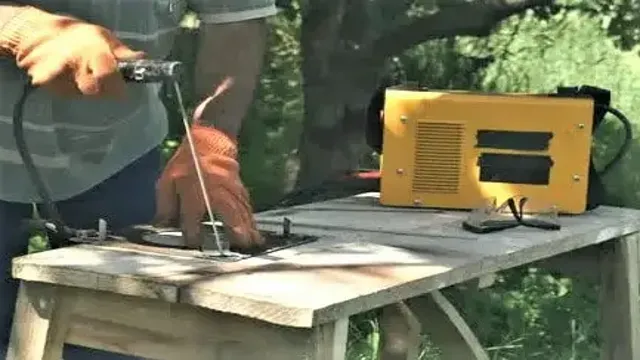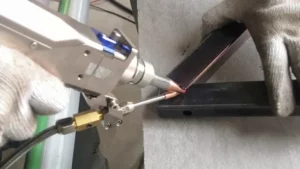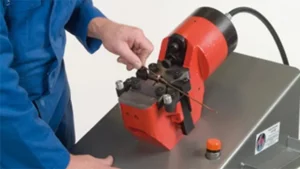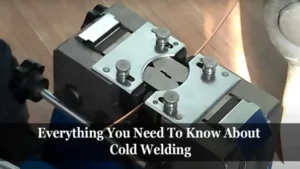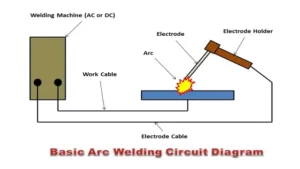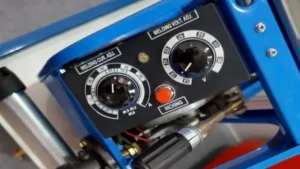If you’re looking to tackle some DIY welding projects or repairs around your home, investing in a welding machine can be a game-changer. But, as a beginner, the thought of using a welding machine can be intimidating. What if you do it wrong? What if you get hurt? Don’t worry, we’ve got you covered.
In this blog post, we’ll explore how to use a welding machine at home, what safety precautions to take, and some tips for success. With a little bit of knowledge, practice, and patience, you’ll be surprised at what you can accomplish with your welding machine. So, let’s dive in!
Introduction
Are you interested in learning how to use a welding machine at home? Welding can be an intimidating hobby to start, but with the right tools and some basic knowledge, it can be a satisfying and practical skill to have. First, ensure that you have all the necessary safety equipment, including gloves, a welding helmet, and protective clothing. Next, make sure that your work area is well-ventilated and free from any flammable materials.
Set up your welding machine according to the manufacturer’s instructions, and practice on scrap metal before attempting any actual projects. Remember to always wear your safety equipment and to stay focused on your work. With patience and practice, you’ll be able to create beautiful and functional welds in no time.
So, why not give it a try and see what you can create with your welding machine!
What is a welding machine?
A welding machine, also known as a welder or welding unit, is a piece of equipment used for joining metals or thermoplastics by applying heat, pressure, or both. This machine works by using an electrical current to create an arc, which melts the metal or plastic to be welded. Once the material has melted and solidified, it forms a joint that is strong and durable.
Welding machines can be found in a variety of settings, from construction sites and auto repair shops to manufacturing plants and shipyards. They come in different sizes and types, each of which is designed for specific welding processes and materials. Some common types of welding machines include stick welders, MIG welders, TIG welders, and plasma cutters.
No matter the type, welding machines play a vital role in numerous industries and are essential for the fabrication and repair of metal structures and components.
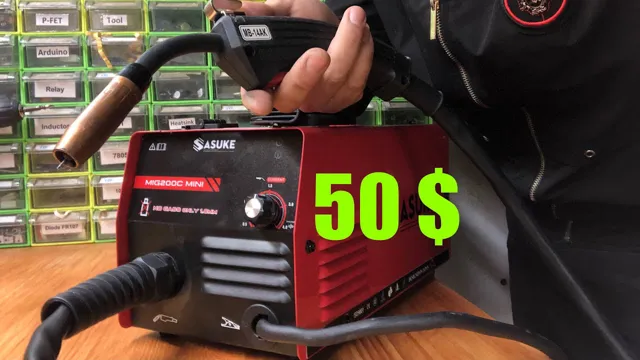
Why use a welding machine at home?
“Welding Machine at Home” Introduction: Welding is a skill that has been around for centuries, and it has come a long way with the advent of technology. Welding machines have made the process much easier and faster, making it possible for just about anyone to weld at home. In this blog post, we will discuss why using a welding machine at home is a fantastic idea and the numerous advantages to doing so.
Using a welding machine at home can be rewarding, especially if you love DIY projects or have a commercial venture that requires welding. It is an excellent investment that comes with countless benefits. You can create or repair metal items without having to rely on a third party.
There is freedom in not having to shell out money every time you need something welded, and you do not have to rely on someone else’s timeline. You also have the option to choose from several welding machines to find the one that best fits your needs. With the right machine, you can weld a variety of metals with varying thickness levels.
In conclusion, having a welding machine in your home has limitless possibilities. It allows you to save money, increase your skill level, and opens up an endless list of DIY projects you can undertake. Welding at home is a great activity that is made even better with a welding machine, and it is an opportunity worth exploring.
Preparing for Welding
If you’re planning to use a welding machine at home, there are a few essential things you need to know before you start. First, it’s crucial to wear proper protective gear, including gloves, a welding mask, and a welding apron. This equipment will help keep you safe while you’re working with the machine.
Next, make sure you have a suitable workspace. Welding produces intense heat and bright light, so you need a space that’s well-ventilated and far away from anything that could catch fire. You’ll also need to prepare the metal you plan to weld by cleaning it thoroughly and ensuring it’s free from any rust, oil, or paint.
Finally, read the instructions that came with your welding machine carefully. Different machines have different settings, and it’s essential to set everything up correctly before you start working. With these tips in mind, you’ll be able to use your welding machine at home safely and with confidence.
Gathering necessary supplies and equipment
When it comes to preparing for welding, gathering the necessary supplies and equipment is crucial. The main keyword here is “preparing for welding,” and it’s important to make sure you have everything you need before getting started. Some of the essential supplies you’ll need include a welding helmet, gloves, apron, and safety glasses to protect yourself from sparks and UV radiation.
You’ll also need welding wire, electrodes, and a welding machine that’s appropriate for the type of welding you’ll be doing. It’s a good idea to invest in high-quality equipment to ensure the best results, as well as to inspect all of your equipment regularly to make sure it’s in good working order. By taking the time to gather everything you need before getting started, you’ll be able to work efficiently and safely, giving you the peace of mind to focus on getting the job done right.
Selecting the right welding machine for your needs
When preparing for welding, it’s important to take a few key steps to ensure a safe and successful project. First off, make sure you’re working in a well-ventilated area or wearing a respirator if needed. Also, clean the area where you’ll be welding thoroughly to remove any potential hazards or debris that could interfere with the welding process.
Additionally, make sure you have the proper safety gear, such as gloves, a welding helmet, and eye protection, to prevent any injuries. Finally, ensure that your welding machine is set up correctly and is appropriate for the type of welding you’ll be doing, whether it’s MIG, TIG, or stick welding. By taking the necessary precautions and preparing properly, you can ensure that your welding project will be successful and safe.
Setting up your workspace for welding
When it comes to welding, having the right workspace setup is crucial to ensure your safety and productivity. First and foremost, your workspace should have good ventilation to prevent inhaling any harmful fumes that are released during the welding process. It’s also important to have a fire extinguisher nearby in case of an accidental fire.
Your workspace should be well-lit so you can see what you’re doing and avoid any accidents. Additionally, you should invest in a good welding table or workbench to securely hold your project in place and prevent any unnecessary movement during welding. Finally, don’t forget to wear appropriate protective gear such as welding gloves, a welding helmet, and a welding jacket to protect yourself from the high heat and sparks that are generated during welding.
With these simple steps, you can create a safe and efficient workspace for all your welding needs.
Using the Welding Machine
If you’re looking to learn how to use a welding machine at home, there are a few things you’ll need to keep in mind. First of all, safety is absolutely critical when working with any kind of welding equipment. You’ll want to make sure you have proper protective gear, including a welding helmet, gloves, and protective clothing.
Next, you’ll need to choose the right type of welding machine for your particular project. There are several different types of welding machines, including MIG, TIG, and stick welders, each with their own strengths and weaknesses. Once you have your equipment set up, it’s important to practice proper welding techniques to ensure a strong and durable weld.
With a bit of practice and patience, anyone can learn to use a welding machine safely and effectively.
Identifying safety measures before starting
When using a welding machine, it is important to identify safety measures before starting. One of the first things to consider is proper ventilation. Welding produces a lot of fumes and gases that can be hazardous to your health if inhaled.
Make sure the area where you will be welding is well-ventilated, and use an exhaust fan or fume extractor if necessary. Wear appropriate safety gear, including a welding helmet, gloves, and protective clothing. Before beginning, inspect the welding machine to ensure it is in good working condition.
Check that the welding cables are not frayed or damaged and that the grounding cable is securely attached. A welding machine can be a powerful tool, but it can also be dangerous if not used properly. Always read and follow the manufacturer’s instructions and be aware of your surroundings.
By taking these safety measures, you can ensure that you stay safe while using a welding machine.
Turning on the welding machine and setting the correct parameters
When it comes to welding, there are many things to consider to ensure a successful job is done. One of the most important things is turning on the welding machine and setting the correct parameters. This may seem like a simple task, but it is crucial for the entire welding process.
First, you need to connect the welding machine to a power source and make sure it is grounded properly. Once the machine is on, the next step is to set the parameters such as the amperage, voltage, and wire speed depending on the type of metal you are working on. Each metal has specific requirements to achieve the desired results, so it is important to consult the manufacturer’s guidelines.
Making sure the welding machine is set up correctly is essential for the success of the welding job.
Positioning the metal pieces to be welded
Positioning the metal pieces before welding is a crucial step to ensure a strong and aesthetically pleasing result. Firstly, you need to clean the metal surface thoroughly of any debris and rust before joining the pieces together. Once cleaned, clamp the metal together and mark the spot where you want to weld with a felt-tip marker or chalk.
This will help you keep your focus and avoid making any mistakes during the welding process. When using the welding machine, make sure to adjust the settings according to the type and thickness of the metal. Using the wrong settings can lead to a weak and brittle weld.
Remember to position yourself comfortably and wear protective gear such as gloves, helmets, and aprons to prevent any accidents. Welding might seem intimidating, but with a steady hand and some practice, you can create beautiful and long-lasting metal structures that can withstand the test of time.
Starting the welding process and monitoring progress
When using a welding machine, there are a few important steps to keep in mind. First, make sure your machine is set up properly according to the type of welding you will be doing and the thickness of the metal you are working with. Once you are ready to begin welding, it’s crucial to maintain a consistent rhythm and speed to achieve a smooth, even weld.
It’s also important to keep an eye on the progress of your weld and make any necessary adjustments to the machine or your technique. This could include adjusting the angle of the torch or increasing the welding current if the weld is not penetrating enough. Remember, practice makes perfect when it comes to welding, so don’t be afraid to experiment and try different techniques until you find what works best for you and the project at hand.
With patience and persistence, you can become a skilled welder in no time.
Post-Welding Care and Maintenance
If you’re looking to use a welding machine at home, it’s essential to understand post-welding care and maintenance. One way to protect your welding projects is to keep them dry and free from moisture. Rust and corrosion can damage the weld, so it’s essential to store your projects in a dry area.
Clean your welding machine regularly by wiping off excess dust and debris. You can also perform routine maintenance, such as changing the oil and filters in your welding machine. It’s crucial to use the appropriate safety gear, such as welding gloves and a welding helmet, to protect yourself during the welding process.
Don’t forget to properly ventilate your workspace to prevent the buildup of fumes and gases. By following these tips, you can use your welding machine at home with confidence and ensure that your welding projects last for years to come.
Allowing the metal to cool down and inspecting the weld
Post-welding care and maintenance is an essential aspect of welding that should not be overlooked. Once the welding process is complete, it’s essential to allow the metal to cool down before any inspection can be conducted. This process helps prevent any potential thermal distortion that might occur immediately after welding.
After cooling, the weld should be carefully inspected to ensure that it meets the required quality standards. This inspection includes checking for cracks, porosity, and any other defects, such as incomplete fusion or undercutting. Maintenance of the weld is crucial in ensuring its durability and reliability.
Regular inspection can help detect any signs of wear or failure, prompting the necessary repairs. Protection against corrosion is also vital to maintain the integrity of the weld. Applying a protective coating to the surface of the weld can help prevent the accumulation of moisture, which could lead to corrosion over time.
In conclusion, post-welding care and maintenance require careful attention to detail to ensure the weld is of the highest quality and durability. Cooling down the metal and conducting an inspection are crucial steps that should be followed strictly. Regular maintenance, such as regular inspections and protection against corrosion, is essential to maintain a weld’s integrity.
So, if you want your weld to last a long time, always ensure that you engage in proper post-welding care and maintenance.
Cleaning the welding machine and storing it properly
After finishing a welding project, it’s essential to take care of your welding machine properly. One of the most crucial steps in post-welding care is cleaning your machine. This is because dirty machines can lead to poor quality welds and equipment damage over time.
Start by carefully unplugging your device and checking for any loose or damaged components to avoid any accidents while cleaning. Remove any debris or dust from the surface of the machine using a soft brush or a clean cloth. Afterward, use a specialized cleaning solution to clean any remaining grime or dirt from the equipment.
Ensure to protect any electrical components as much as possible while cleaning. After cleaning, it’s essential to store your machine correctly. Be sure to keep it in a dry and secure area, away from any moisture or extreme temperatures as they can damage your device.
Properly storing your welding machine will ensure its longevity and keep it in pristine condition for future projects.
Conclusion
In conclusion, using a welding machine at home can be a DIY enthusiast’s dream come true. However, always ensure you take appropriate safety measures such as protective clothing and proper ventilation. Remember to familiarize yourself with the different welding techniques and choose the right welding machine for the job.
And if all goes well, you’ll be on your way to creating metal masterpieces that will make your friends and family marvel at your newfound skills. So, grab your welding gear and let your creativity ignite – the world is your molten oyster!”
Tips for becoming a proficient welder at home
Post-welding care and maintenance is essential to promote the longevity and durability of your welding projects. After completing a welding task, it’s crucial to clean the area with a wire brush to remove any slag or debris left behind from the welding process. Additionally, you should inspect the weld joints to ensure that they are clean and free from defects.
It’s also advisable to apply an anti-spatter solution to prevent future weld spatter from forming on the surface. Furthermore, it’s important to store your welding equipment properly in a dry and secure place to prevent rust and other damages. Proper care and maintenance will ensure that your projects look great and last for a long time.
So don’t forget to take care of your welding equipment to make your projects shine!
Common welding mistakes and how to avoid them
When it comes to welding, post-welding care and maintenance are just as important as the actual welding process itself. One of the most common mistakes people make is neglecting to properly clean and protect their welded pieces after the job is done. This can lead to corrosion, structural damage, and reduced lifespan of the product.
To avoid this, it’s crucial to clean the weld area thoroughly, removing any slag or debris. After cleaning, applying a protective coating such as paint or a specialized rust inhibitor can help prevent corrosion and keep the weld area in good condition. Additionally, it’s important to routinely inspect and maintain welded pieces to ensure they remain structurally sound and safe.
By taking the time to properly care for your welded products, you can maximize their lifespan and ensure they perform their intended function for years to come.
Additional resources for learning how to weld at home
When it comes to welding, it’s important to keep in mind that post-welding care and maintenance are just as important as the actual welding process itself. After all, you don’t want all your hard work to go to waste due to neglecting post-welding care! One thing to keep in mind is that your welds need time to cool down after completing the welding process. You can encourage the cooling process by leaving the metal in the open air and avoiding contact with water or other coolants.
Another important step is to clean the weld area thoroughly, removing any debris or slag that may have accumulated during welding. Additionally, keep an eye on the weld for any signs of damage or weakness, and address any issues as soon as possible to avoid further problems down the line. With proper post-welding care and maintenance, you can ensure that your welding projects will stand the test of time!
FAQs
How do I set up a welding machine at home?
First, choose a safe and well-ventilated workspace. Read the manufacturer’s instructions for your specific welding machine and assemble it accordingly. Connect the electrodes or wire to the machine and adjust the voltage and amperage settings according to the thickness of the metal you will be welding.
What safety measures should I take when welding at home?
Always wear protective gear such as a welding mask, gloves, and apron. Make sure the area is well-ventilated and free from flammable materials. Keep a fire extinguisher nearby and have a second person present in case of emergency.
What types of welding machines are suitable for home use?
There are several types of welding machines such as MIG, TIG, and stick welders. Choose the type that best suits your welding needs and skill level.
How do I choose the right electrodes or wire?
Consider the thickness and type of metal you will be welding as well as the amperage and voltage requirements of your specific machine. Consult the manufacturer’s instructions or seek advice from a professional if needed.
How do I create a strong weld?
Make sure the metal is clean and free from rust, paint, or other debris before welding. Use the appropriate amperage and voltage settings for the metal thickness. Use a steady hand and make sure the electrodes are positioned correctly.
Can I weld aluminum at home?
Yes, it is possible to weld aluminum at home with a specialized TIG welding machine and the appropriate electrodes or filler wire.
How can I maintain and care for my welding machine?
Clean the machine regularly to prevent buildup of dirt or debris. Check for any damaged or frayed cords and replace them if necessary. Store the machine in a dry and safe location when not in use.
